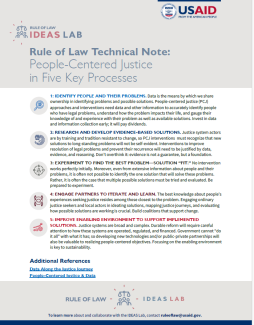1: IDENTIFY PEOPLE AND THEIR PROBLEMS. Data is the means by which we share ownership in identifying problems and possible solutions. People-centered justice (PCJ) approaches and interventions need data and other information to accurately identify people who have legal problems, understand how the problem impacts their life, and gauge their knowledge of and experience with their problem as well as available solutions. Invest in data and information collection early; it will pay dividends.
2: RESEARCH AND DEVELOP EVIDENCE-BASED SOLUTIONS. Justice system actors are by training and tradition resistant to change, so PCJ interventions must recognize that new solutions to long-standing problems will not be self-evident. Interventions to improve resolution of legal problems and prevent their recurrence will need to be justified by data, evidence, and reasoning. Don’t overthink it: evidence is not a guarantee, but a foundation.
3: EXPERIMENT TO FIND THE BEST PROBLEM—SOLUTION “FIT.” No intervention
works perfectly initially. Moreover, even from extensive information about people and their problems, it is often not possible to identify the one solution that will solve these problems. Rather, it is often the case that multiple possible solutions must be tried and evaluated. Be prepared to experiment.
4: ENGAGE PARTNERS TO ITERATE AND LEARN. The best knowledge about people’s experiences seeking justice resides among those closest to the problem. Engaging ordinary justice seekers and local actors in ideating solutions, mapping justice journeys, and evaluating how possible solutions are working is crucial. Build coalitions that support change.
5: IMPROVE ENABLING ENVIRONMENT TO SUPPORT IMPLEMENTED SOLUTIONS. Justice systems are broad and complex. Durable reform will require careful attention to how these systems are operated, regulated, and financed. Government cannot “do it all” with what it has; so developing new technologies and/or public-private partnerships will also be valuable to realizing people-centered objectives. Focusing on the enabling environment is key to sustainability.

